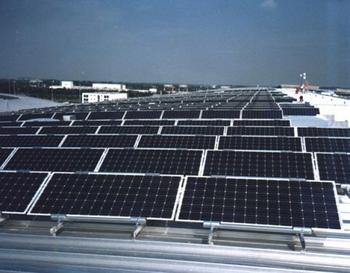 The State Grid Corporation of China officially released the "Opinions on the Implementation of Distributed Photovoltaic Power Grid-connected Services" on the 26th, marking a significant step forward for the solar energy sector. Following this, provinces under the State Grid have also rolled out detailed guidelines for grid connection. As a result, micro-inverters are gaining popularity among PV module manufacturers and EPC companies due to their multiple advantages—such as higher energy output, longer lifespan, and easier installation and maintenance.
At APS’s domestic sales headquarters in Shanghai, the phones have been ringing non-stop as customers inquire about mini-inverter products. According to the regional sales manager, “In the past, we had to spend a lot of time explaining the benefits of micro-inverters. Although customers recognized the advantages, they were often discouraged by policy restrictions. However, with the recent release of national policies, now more and more customers are proactively reaching out. Even some companies are offering cash payments just to get the systems installed.â€
With the latest distributed power generation policy, Shanghai Power has started accepting distributed photovoltaic systems for grid connection. Currently, early adopters are already preparing to install 1 kW systems on their rooftops. A sales manager from Luneng Solar provided a detailed cost-benefit analysis for a customer. Based on the calculation, a 1 kW system is expected to generate around 21,900 kWh over its 20-year lifespan. Under current national policies, the electricity company purchases power at 1 yuan per kWh, totaling 21,900 yuan. Meanwhile, the initial investment for a 1.5 kW system is approximately 9,000 yuan, meaning the customer could earn an estimated 12,900 yuan in revenue.
According to Sunergy PV sales personnel, “Recently, some real estate developers have begun entering the micro-inverter market, and their demand is quite large. This situation has never been seen before, and many of them may not have even connected to the grid previously. The residential market holds a lot of untapped potential, and it seems that the era of large-scale adoption of micro-inverters is finally here.â€
Compared to centralized inverters, many domestic customers have realized that these traditional systems lack advantages in distributed generation projects. Issues like low efficiency, short lifespan, and difficult maintenance can seriously impact system stability and reduce investor returns.
A market analyst from an industry media noted, “Some EPCs in Jiangsu used to rely on centralized inverters. Recently, however, some investors have started retrofitting older systems with micro-inverters instead.â€
During the tough times in the PV industry, component manufacturers and EPCs have been struggling, much like the mythical phoenix rising from ashes. Micro-inverters might just be the spark that revives the entire sector. The days of ignoring energy output, plant lifespan, and price wars may be over. This is a promising opportunity for the solar industry. Shanneng Solar will continue to play a key role in advancing China's distributed photovoltaic technology and market development.
The State Grid Corporation of China officially released the "Opinions on the Implementation of Distributed Photovoltaic Power Grid-connected Services" on the 26th, marking a significant step forward for the solar energy sector. Following this, provinces under the State Grid have also rolled out detailed guidelines for grid connection. As a result, micro-inverters are gaining popularity among PV module manufacturers and EPC companies due to their multiple advantages—such as higher energy output, longer lifespan, and easier installation and maintenance.
At APS’s domestic sales headquarters in Shanghai, the phones have been ringing non-stop as customers inquire about mini-inverter products. According to the regional sales manager, “In the past, we had to spend a lot of time explaining the benefits of micro-inverters. Although customers recognized the advantages, they were often discouraged by policy restrictions. However, with the recent release of national policies, now more and more customers are proactively reaching out. Even some companies are offering cash payments just to get the systems installed.â€
With the latest distributed power generation policy, Shanghai Power has started accepting distributed photovoltaic systems for grid connection. Currently, early adopters are already preparing to install 1 kW systems on their rooftops. A sales manager from Luneng Solar provided a detailed cost-benefit analysis for a customer. Based on the calculation, a 1 kW system is expected to generate around 21,900 kWh over its 20-year lifespan. Under current national policies, the electricity company purchases power at 1 yuan per kWh, totaling 21,900 yuan. Meanwhile, the initial investment for a 1.5 kW system is approximately 9,000 yuan, meaning the customer could earn an estimated 12,900 yuan in revenue.
According to Sunergy PV sales personnel, “Recently, some real estate developers have begun entering the micro-inverter market, and their demand is quite large. This situation has never been seen before, and many of them may not have even connected to the grid previously. The residential market holds a lot of untapped potential, and it seems that the era of large-scale adoption of micro-inverters is finally here.â€
Compared to centralized inverters, many domestic customers have realized that these traditional systems lack advantages in distributed generation projects. Issues like low efficiency, short lifespan, and difficult maintenance can seriously impact system stability and reduce investor returns.
A market analyst from an industry media noted, “Some EPCs in Jiangsu used to rely on centralized inverters. Recently, however, some investors have started retrofitting older systems with micro-inverters instead.â€
During the tough times in the PV industry, component manufacturers and EPCs have been struggling, much like the mythical phoenix rising from ashes. Micro-inverters might just be the spark that revives the entire sector. The days of ignoring energy output, plant lifespan, and price wars may be over. This is a promising opportunity for the solar industry. Shanneng Solar will continue to play a key role in advancing China's distributed photovoltaic technology and market development.Wuxi Ding Guohua Hand drawn Wallpaper Co., Ltd , https://www.silkwallpaperasia.com